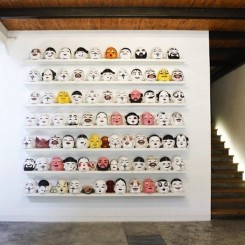Qiu Zhijie: “Satire”
Galleria Continua (2 Jiuxianqiao Road, 798 Art District, Chaoyang district) Sep 26–Dec 1, 2013
A while back, I was walking by the back door of Galleria Continua, when I spied Qiu Zhijie busying with the preparations for his upcoming opening. I happened to overhear him speaking to someone nearby, saying “all of the burnt books upstairs were once banned.” Hearing this, I guessed Qiu had once again chosen the topic of “traditional culture” for his upcoming show. It turns out I was right—all of Qiu Zhijie’s work and every aspect of his work have always come about with such exquisite reasons.
Each piece in his current series is meant to reference Umberto Eco’s murder mystery novel The Name of the Rose (interested readers can refer to the relevant exhibition literature or the book itself). A number of masks are arranged on a table and a wall near the entry way. The options visitors can choose from are many, including likenesses of contemporary tyrants, religious figures, mythological images, Japanese Noh theater characters, clowns, and monsters, but apart from the band of musicians performing at the exhibition, few actually elect to enter the gallery with a temporary mask. The band’s performance is savage and grotesque, echoing through the vaulting spaces of the gallery, which give the music an extra layer of the unsettling. Overall, the atmosphere is hellish and sinister, bringing to mind an artist’s rendering of the depths of the underworld.

Qiu Zhijie, “Forbidden Books, ” ashes of burnt books, variable dimensions, 2013
邱志杰, 《禁书》,书的灰烬,可变尺寸,2013,

Qiu Zhijie, “Greeting,” paper masks, silicon masks, variable dimensions, 2013
邱志杰, 《笑脸相迎》,纸制面具,硅胶面具,尺寸可变,2013

Qiu Zhijie, “The Plan of 100 Unicorns,” variable dimensions, project started in 2012 until now.
邱志杰, 《100只独角兽计划》,可变尺寸,2012年开始至今
A piece with a more medieval feel is a structure formed of jet-black wooden crossbars at the center of the exhibition space. Reminiscent of the framework of a monastery, it is a reference to the burnt down monastery library detailed in Eco’s novel. Regrettably, the little carved Buddha figures at the base of each wooden pillar muddy the waters. Eco’s novel never once mentioned any Buddhist figures, so it is impossible to relate the two disparate themes. Certainly, the artist himself must be able to conjure some sort of satisfactory explanation for the mash-up. Absent of such elucidation, I have to form a supposition from a practical point of inference: the artist must have made the addition for fear the work is not quite grounded, in order to acclimatize his pieces to the local conditions.

Qiu Zhijie, “Elysian Fields,” crossties, bamboo root carvings, electrical machines, 620 x 580 x 550 cm, 2013
邱志杰, 《极乐世界》,枕木,竹根雕,电机,620 x 580 x 550厘米, 2013

Qiu Zhijie, “Elysian Fields,” crossties, bamboo root carvings, electrical machines, 620 x 580 x 550 cm, 2013
邱志杰, 《极乐世界》,枕木,竹根雕,电机,620 x 580 x 550厘米, 2013
This melange of meaning is further explored in the nearby piece entitled “The Plan of 100 Unicorns”, which is composed of several extremely bizarre carvings. Each carving is a creature formed of the body parts of various beasts, calling to mind the nameless and formless monsters in the mythology from the distant, archaic past. Though odd, they remain moving and vivid; more importantly, they were carved with excellent craftsmanship from high-quality timber. Additionally, Qiu has displayed the contracts commissioning these sculptures on the gallery wall, thus introducing the currently trendy concepts of “production and value” and “case study” into the mix of ideas being explored at the exhibition.
Overall, the show pays its dues to The Name of the Rose. The ashen remnants of the banned books Qiu Zhijie mentioned are placed right in the middle of the gallery’s upstairs exhibition space, which recalls the novel’s plotline. Of course, in this context, book burning also very naturally leads viewers to think of topics such as the burning of books and burying of scholars in the Qin dynasty (221–206 BC), the various literary inquisitions in history, and even the current topics of freedom of speech as well as the government’s new policy on “rumour-mongering”. In short, the viewer soars on the pile associations…
Perhaps this says something about Qiu’s train of thought in planning this show: by filling the gallery spaces with pieces both conceptual and substantial, he then transforms the exhibition space into a “field of hidden meaning”, causing visitors to engage in endless debate about the artist’s intent. Researchable, explorable, collectible—and expressive of nostalgic sentiments. Anything a contemporary person is concerned with can be found in one way or another in his works.

Qiu Zhijie, “Cannot Hold Ita Anymore,” books, Elmo toys, variable dimensions, 2013
邱志杰, 《实在是憋不住了》,书籍,艾摩玩具,可变尺寸,2013
Some books were incinerated for the sake of art, but others, also for the sake of creating works, have been displayed much like family treasures as part of other works. In “Cannot Hold It Anymore” (2013), the artist has arranged Elmo dolls in front of various volumes. All of the books deal with hotly debated political and cultural topics, and are in this way similar to the masks downstairs—they are yet another departure from the central theme of the exhibition. There is one book among the selection which might truly be important to Qiu Zhijie: Critical Terms for Art History. Though the title mentions “terms”, the volume is much more than a simple set of entries accompanied by commentary; it is a collection of essays focused on contemporary art criticism. The editor, Robert S. Nelson invited leading scholars in the field of humanities to contribute entries according to their specialties, dealing intimately with contemporary art and art history. The topics explored in the volume include representation, sign, narrative, performance, style, context, meaning/interpretation, originality, appropriation, art history, modernism, avant-garde, primitive, memory/monument, body, beauty, ugliness, ritual, fetish, gaze, identity, production, commodity, collecting/museums, value, post-modernism/post-colonialism, among many, many others.
Simply put, most of Qiu Zhijie’s work in recent years can be described as having two main qualities: narrative, and collectible. Clearly, Qiu is as clever as he is well-read.

